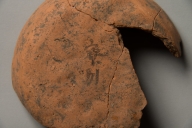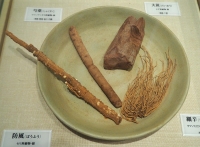The Saikuryo
Organization of the Saikuryo
The Saiku housed a state government office called the Saikuryo, or Saio’s Office.The Saikuryo had twelve departments involved in the running of the Saiku under an aristocrat holding the title of Chokan (head or chief officer of the Saikuryo). It also included bodies involved in religious rituals.
The Saiku employed many highly-educated women as court ladies, and was probably the only place in ancient Japan outside the capital where this occurred.
Some bear names of offices and official titles written in black ink, and provide clues about the Saikuryo’s activities as a government office.
The Saikuryo’s finances
Systems were in place at the Saiku for financially supporting the Saio’s living expenses, as well as the Saikuryo’s activities as a government office. In the year 730, the state government decided to fund the Saiku through part of its tax revenue. Goods collected as taxes were transported to the Saiku from various parts of eastern Japan.The Saiku gradually declined after the taxation system deteriorated during and after the 10th century, making it difficult for the role of the Saiku to be sustained.
Earthenware inscribed with “ryo” in black in
 The Saiku complex included the Saikuryo, a government office serving the Saio. Although it was thought that the Saikuryo during the Heian period (late 8th to 12th centuries) was located within blocks of the site that had been uncovered by archaeological excavations, definitive proof of its presence had long evaded researchers. This earthenware fragment inscribed with the character ryo, retrieved from a relevant block of the site, provided the long-awaited proof that the blocks in question were indeed the location of the Saikuryo.
The Saiku complex included the Saikuryo, a government office serving the Saio. Although it was thought that the Saikuryo during the Heian period (late 8th to 12th centuries) was located within blocks of the site that had been uncovered by archaeological excavations, definitive proof of its presence had long evaded researchers. This earthenware fragment inscribed with the character ryo, retrieved from a relevant block of the site, provided the long-awaited proof that the blocks in question were indeed the location of the Saikuryo.
Herbal medicines
 The Engishiki, which contains general laws and rules pertaining to the Saiku, also includes a list of medicines used by the department within the Saiku responsible for medical matters. Most of the medicines were obtained from plant roots, and are still in use today as herbal medicines, demonstrating how little the knowledge of herbal medicine has changed over time.
The Engishiki, which contains general laws and rules pertaining to the Saiku, also includes a list of medicines used by the department within the Saiku responsible for medical matters. Most of the medicines were obtained from plant roots, and are still in use today as herbal medicines, demonstrating how little the knowledge of herbal medicine has changed over time.
